Nov. 11 update on COVID-19 in MN: Record 56 deaths; hospitalizations climbing

Updated: 4:20 p.m.
Minnesota public health leaders for weeks have warned the state’s skyrocketing COVID-19 caseload would bring more hospitalizations — and deaths. Those warnings are coming to pass.
The Health Department reported 56 more COVID-19 deaths, shattering the pandemic’s previous single-day record of 36, which happened Friday. Wednesday’s awful number puts Minnesota’s seven-day trend above 30 deaths a day for the first time in the pandemic.

The seven-day hospital admissions trend also rose to a pandemic record. About 1,300 people are in Minnesota hospitals now because of COVID-19, with nearly 300 needing intensive care, according to Health Department data.
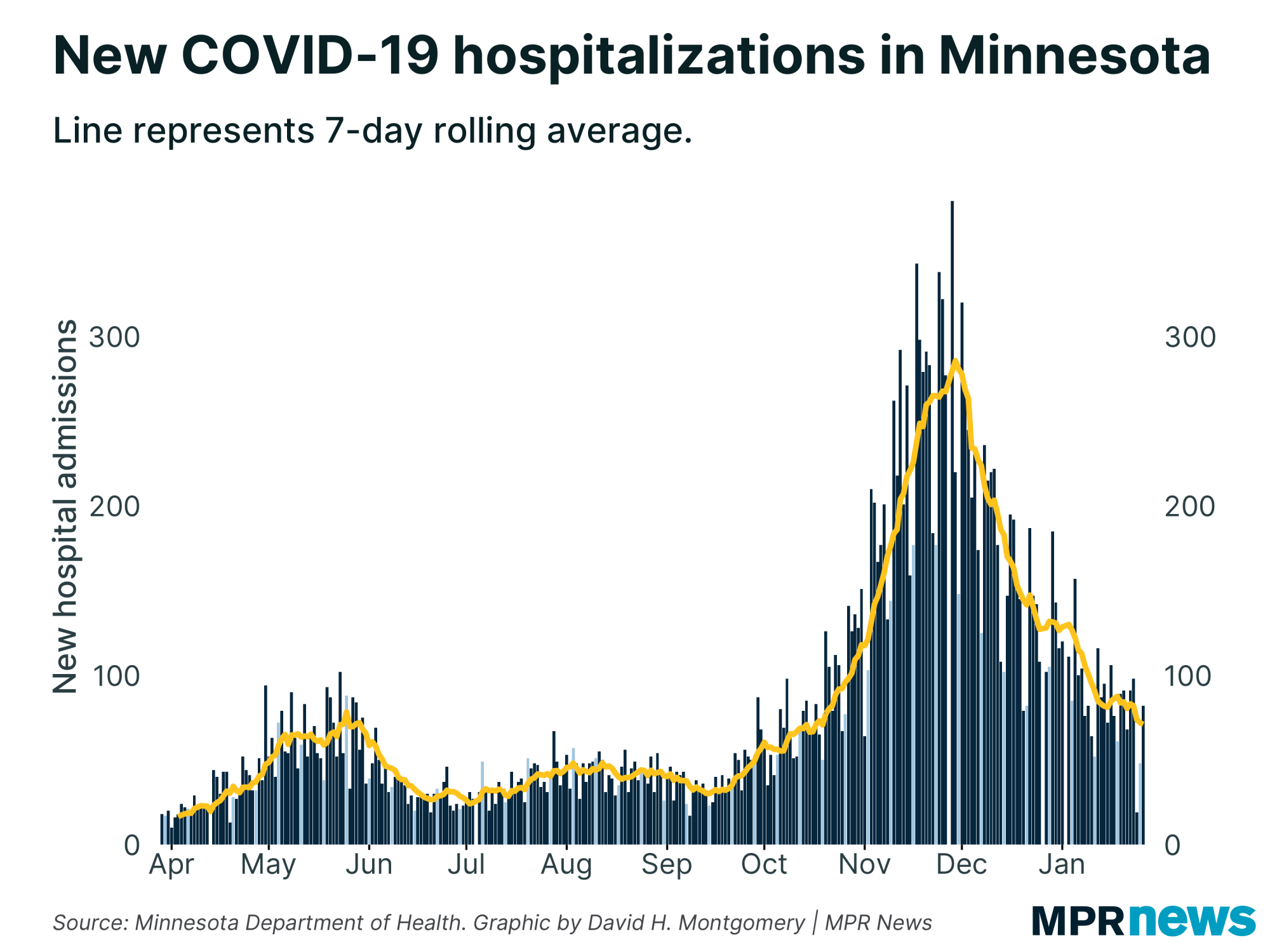
Active cases of the disease remain at record levels. Officials on Wednesday recorded another 4,900 newly confirmed or probable cases.
Create a More Connected Minnesota
MPR News is your trusted resource for the news you need. With your support, MPR News brings accessible, courageous journalism and authentic conversation to everyone - free of paywalls and barriers. Your gift makes a difference.
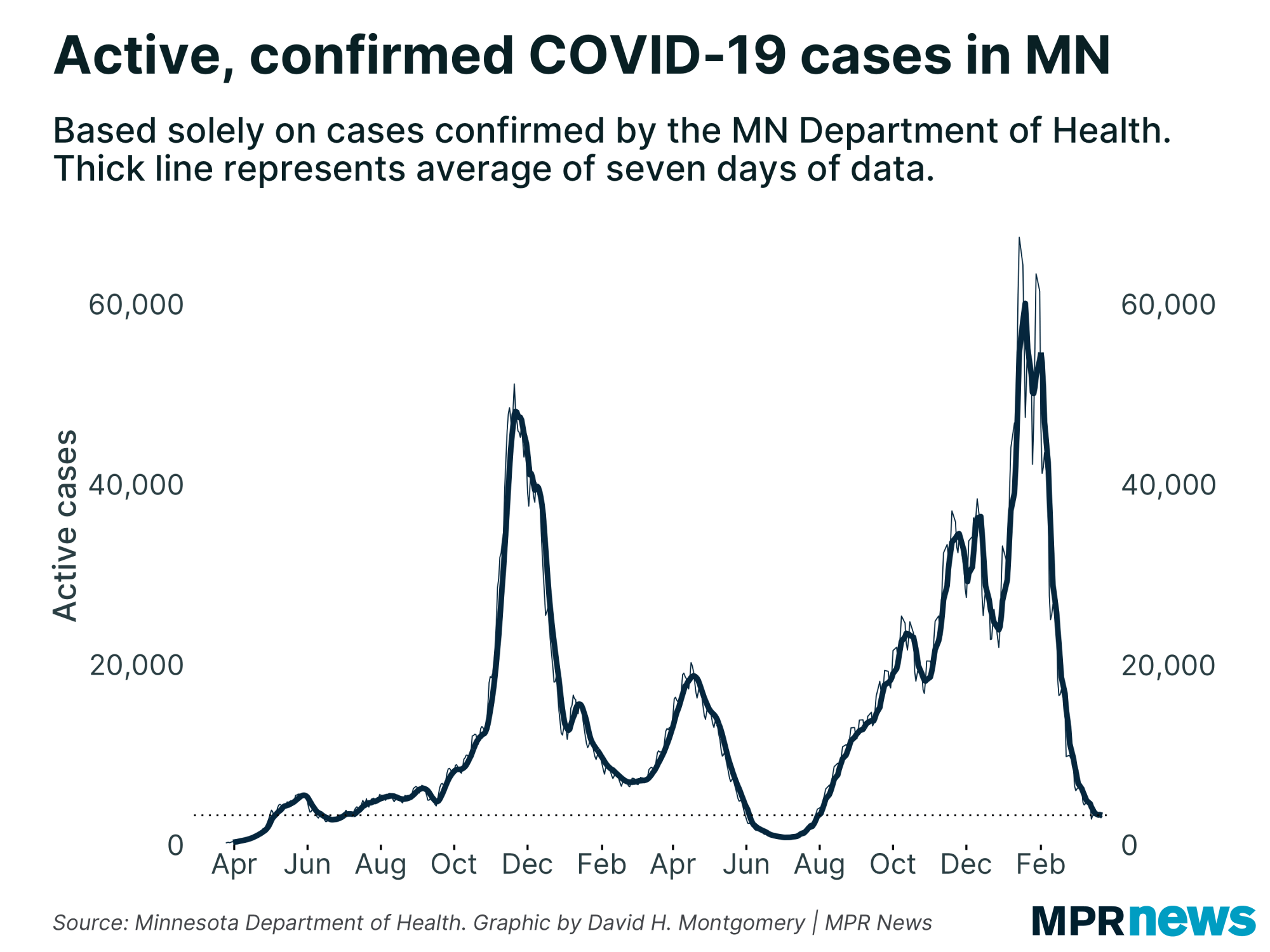
The unhappy data comes a day after Gov. Tim Walz tightened restrictions on late-night social life to stem the spread of the disease. In a Wednesday morning interview with MPR News, he signaled that a daily record for deaths was imminent.
"This is just inevitable if we do not change our behaviors and take some mitigation efforts, this will continue to spike,” he said.
The disease’s rampant spread is being fueled by informal gatherings and get-togethers with family and friends, transmitted unknowingly by people who have the virus but do not have symptoms, officials say.
Of the 194,570 confirmed or probable cases identified in the pandemic to date, about 81 percent have recovered to the point they no longer need to be isolated.
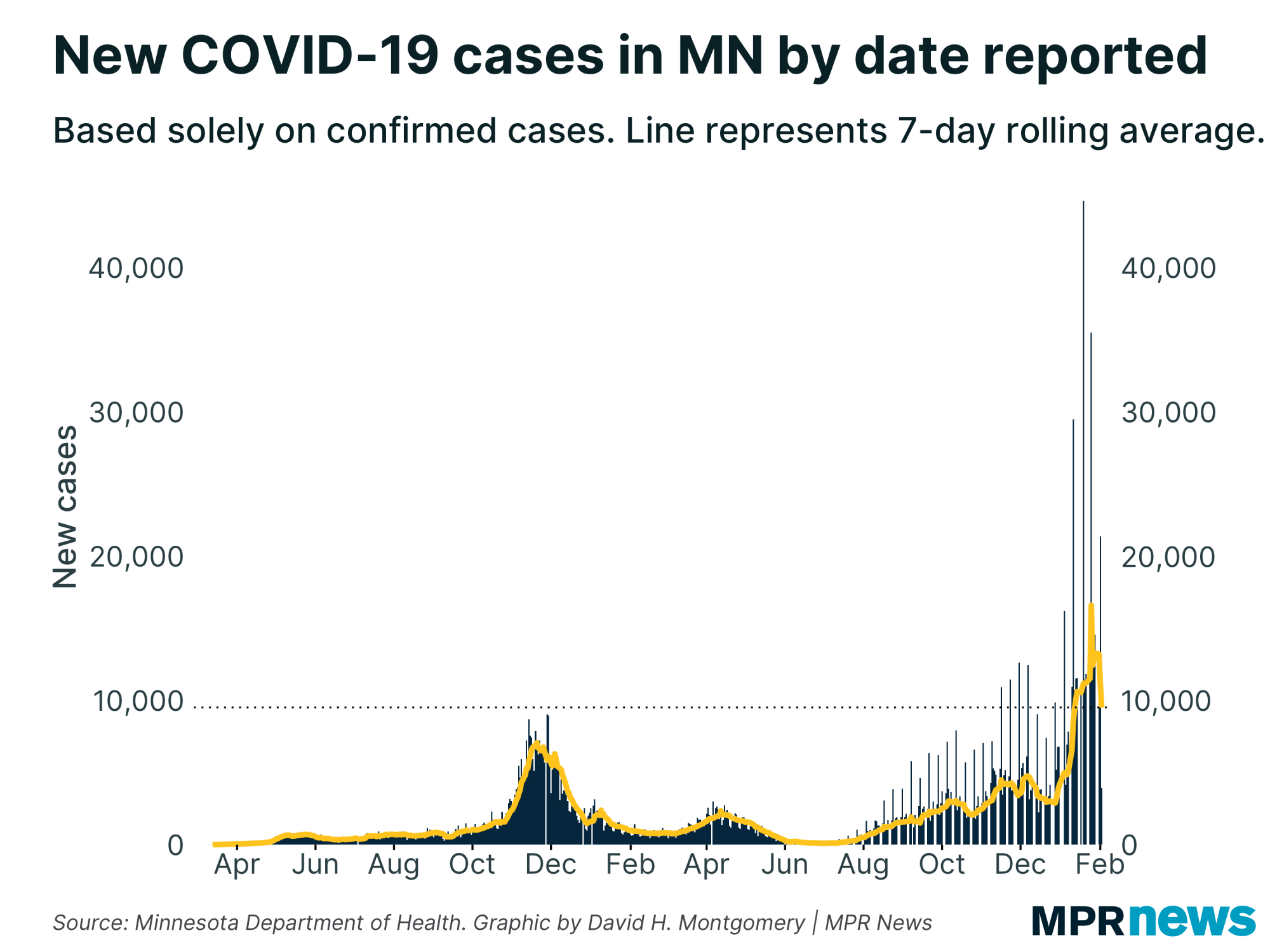
The newest case numbers came on relatively flat levels of testing resulting in a spike in the rate of positive tests to more than 30 percent, a new record high. The seven-day positive test average is now 15.6 percent, just shy of the May peak.
Officials become concerned when the rate goes above 5 percent.
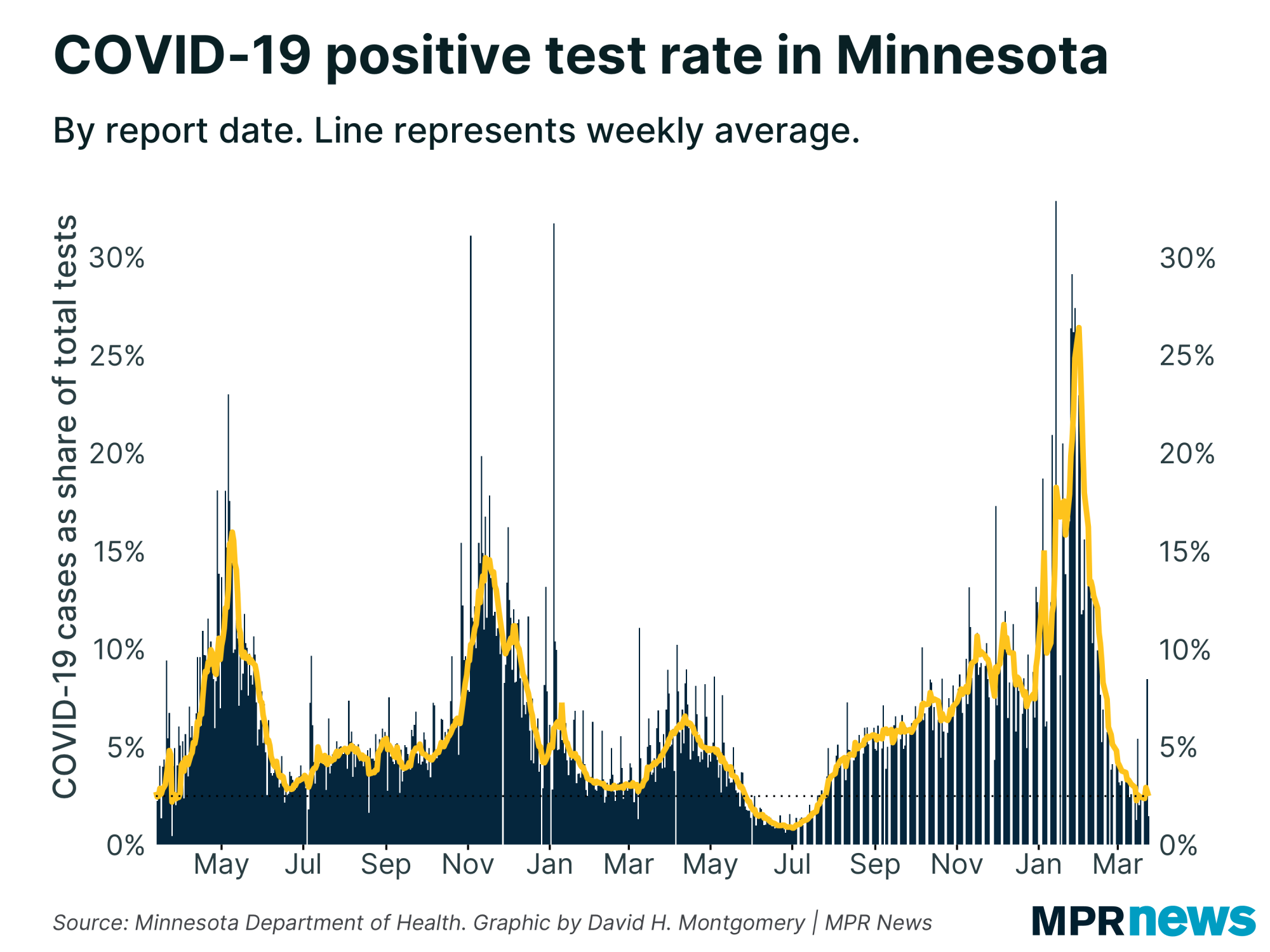
The deaths reported Tuesday raised Minnesota’s toll to 2,754. Among those who’ve died, about 69 percent had been living in long-term care or assisted living facilities; most had underlying health problems.
Caseloads rising across age groups
New cases are up dramatically over the past six weeks in all age groups.
People in their 20s still make up the age bracket with the state’s largest number of confirmed cases — more than 40,000 since the pandemic began, including more than 22,000 among people ages 20-24.
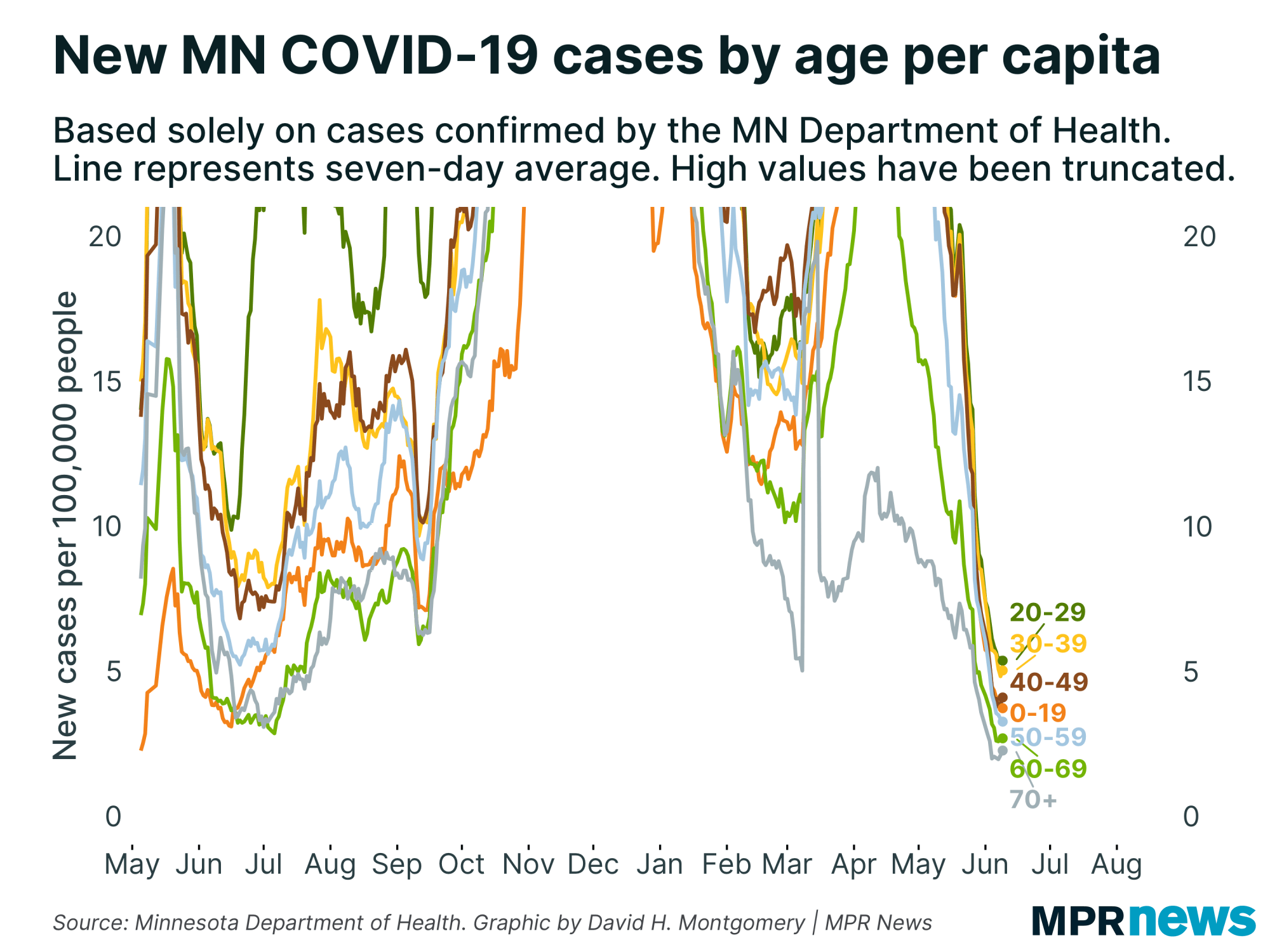
The number of high school-age children confirmed with the disease has also grown, with some 16,000 total cases among children ages 15 to 19 since the pandemic began.
Those numbers help explain why experts remain particularly concerned about teens and young adults as spreaders of the virus.
While less likely to feel the worst effects of the disease and end up hospitalized, experts worry youth and young adults will spread it to grandparents and other vulnerable populations. It’s especially concerning because people can have the coronavirus and spread COVID-19 when they don’t have symptoms.
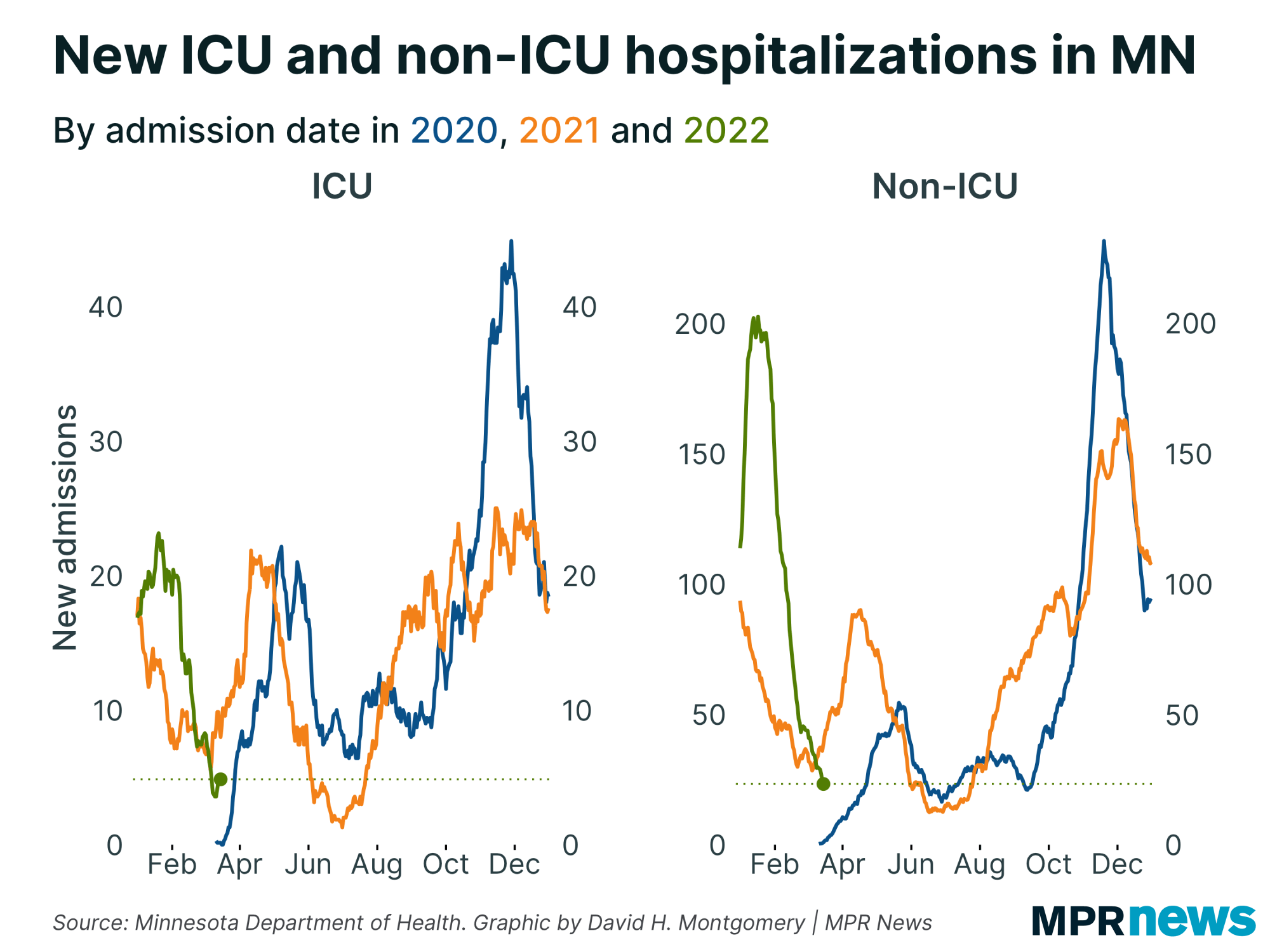
Walz on Tuesday said the state has data showing infection rates rising around bar and restaurant activity after 9 p.m. among people ages 18 to 35, noting that people who have the virus but don’t have symptoms are unwittingly spreading it.
“This is dangerous because we can’t see it,” Walz said. “They are not sick,” he said of asymptomatic people, “but they are infected and they are contagious.”
Virus surges in swaths of rural Minnesota
Regionally, central and northern Minnesota have driven much of the recent increase in new cases while Hennepin and Ramsey counties show some of the slowest case growth in the state.
Northwestern Minnesota no longer has the state’s fastest-growing outbreak. It’s been passed by east-central Minnesota. But new cases are rising at accelerating rates everywhere.
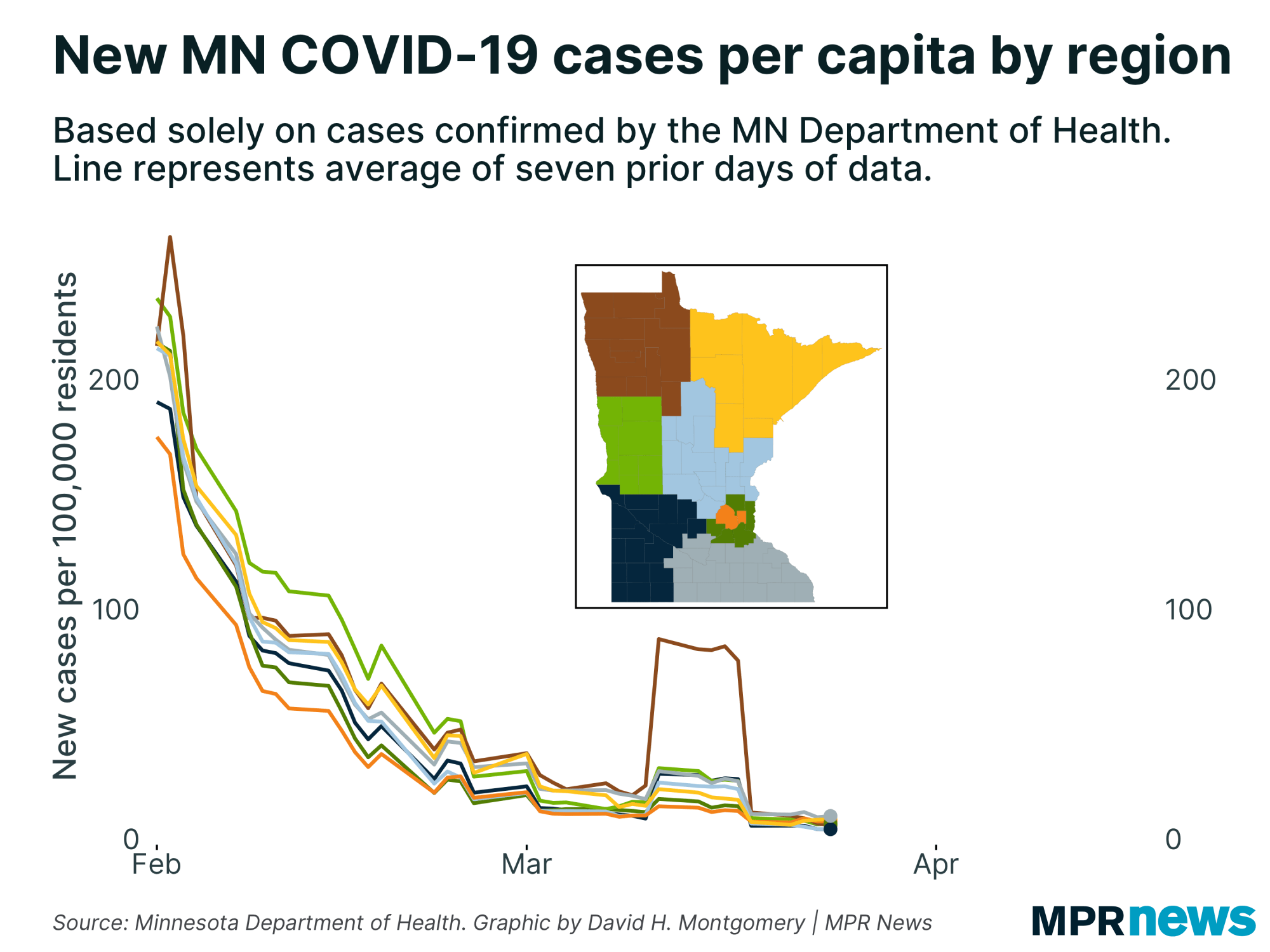
Collectively, rural areas of Minnesota continue to report the most new COVID-19 cases.
Northern Minnesota, once the region least affected by the disease, has also seen its caseload grow dramatically in recent weeks.
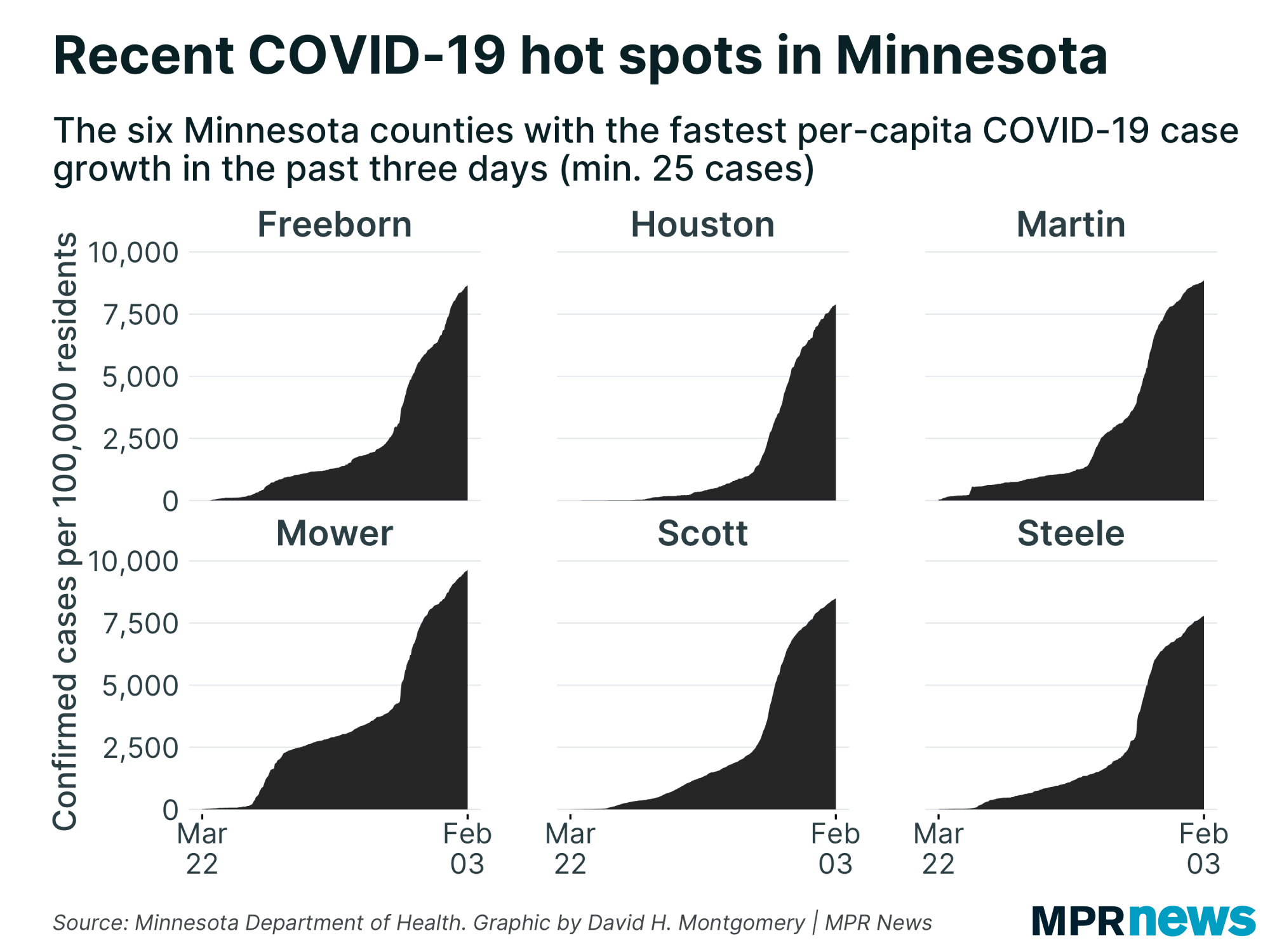
In Itasca County in northeastern Minnesota, COVID-19 cases are surging to the point that county health officials have suspended individual contact tracing, citing a record high rate of infections through community transmission.
“If you are in a group setting, just assume that someone has COVID,” said Kelly Chandler, department manager for Itasca County Public Health, in a press release.
Latino cases jump
In Minnesota and across the country, COVID-19 has hit communities of color disproportionately hard in both cases and deaths. That’s especially true for Minnesotans of Hispanic descent.
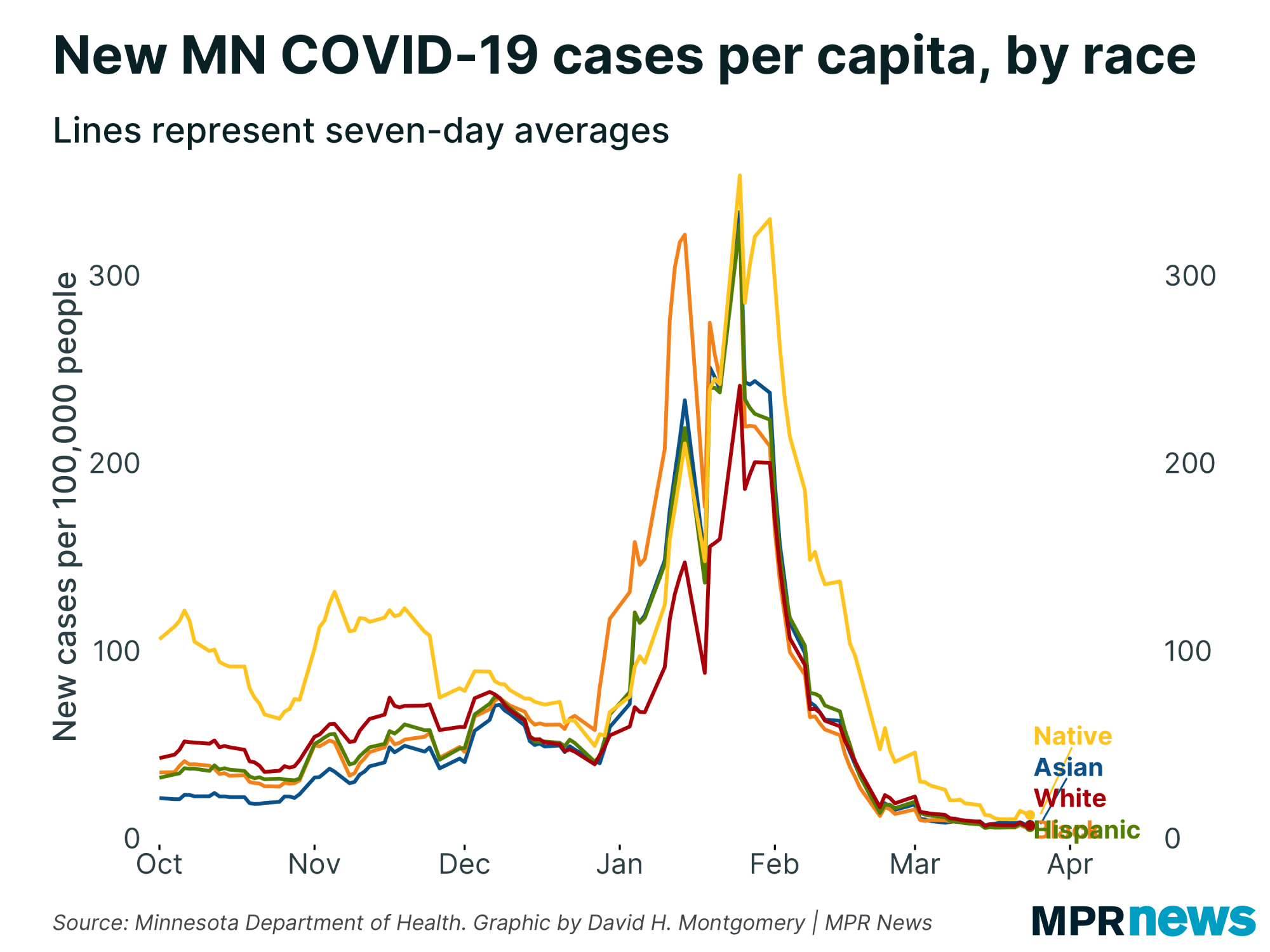
Distrust of the government, together with deeply rooted health and economic disparities, have hampered efforts to boost testing among communities of color, officials say, especially among unauthorized immigrants who fear their personal information may be used to deport them.
Similar trends hold true for Minnesota’s Indigenous residents. Counts among Indigenous people jumped in October relative to population.
Cases among all races and ethnicities continue to rise, although currently the growth is slowest among Black Minnesotans, who reported the most new COVID-19 cases per capita for much of the spring and summer.
‘So much virus circulating in our state’
The overall numbers continue to paint a troubling picture of a rapidly worsening pandemic in Minnesota not limited to just one region or demographic group, like earlier in the pandemic.
There’s increasing concern about the ability of hospitals to handle more. They were already filling in the summer and fall from normal use, and the surge in COVID-19 patients is putting hospitals in the Twin Cities “near the top of their capacity,” Health Commissioner Jan Malcolm said last week.
Staffing is becoming a challenge as more health care workers get sick, she added.
“Minnesota is in a bad spot … and it’s going to get worse before it gets better,” Kris Ehresmann, the state’s infectious disease director, told reporters last week.
While more testing is uncovering more cases, “it’s not the testing that’s the problem,” Ehresmann said. “It’s the sheer fact that we have so much virus circulating in our state.”
Developments around the state
State prison in St. Cloud locked down to combat COVID
The Minnesota state prison in St. Cloud is under modified lockdown due to a recent spike in COVID-19 cases among inmates and staff.
Recently the facility has reported 381 total positive or presumed positive cases in St. Cloud since the pandemic began, up from 179 in late October. 169 of those cases have recovered.
St. Cloud serves as the intake facility for the state prison system. In July, the Minnesota Department of Corrections temporarily moved intake operations to Lino Lakes due to a COVID-19 outbreak in St. Cloud.
Corrections Commissioner Paul Schnell said they are considering whether to do that again.
"We are looking at what the alternatives are. The challenge really, at this time, we're trying to do everything we can to reduce intakes altogether,” Schnell said. “We've asked the county jails, if they would hold people for two weeks, to allow us to try and settle this."
However, Schnell says many county jails are dealing with their own spikes of coronavirus cases.
Schnell said facilities across the Midwest are seeing similar spikes, as community spread of the virus increases.
"Whether it's a correctional facility, nursing home, you can't have a massive growth in the community and not expect that to ultimately influence these congregate settings."
Schnell said the department is taking steps to contain the spread of the virus, including minimizing inmates' movement with a modified lockdown, testing of staff and inmates, and quarantining newly arriving inmates for two weeks.
— Kirsti Marohn | MPR News
MN opening more sites for free COVID testing
Minnesota is adding more than a dozen new COVID-19 testing locations over the next couple of weeks, including 10 in armories around the state and several locations at Minneapolis-St. Paul International Airport.
On Monday, the state opened a saliva testing site at the Minneapolis Convention Center. Similar testing is already available free of charge at sites in St. Paul, Mankato, Winona, Brooklyn Park, Moorhead, Duluth and St. Cloud.
Health Commissioner Jan Malcolm said the saliva test is as effective as ones that use nasal swabs.
"There's more than one type of saliva test. This one was I believe the first that got FDA emergency use authorization and the reliability is very high,” Malcolm said.
Testing is free and available to anyone who wants to be tested whether they have symptoms or not. The state does not require identification or insurance for saliva testing, but does recommend that patients make an appointment. The tests taken at the Minneapolis Convention Center will be analyzed at a lab in the state and results should be available in 24 to 48 hours, state health officials say.
Other types of testing are available at medical clinics, pop-up sites and temporary locations throughout the state.
Health authorities recommend testing for anyone who is exhibiting symptoms, or people who have been exposed, think they've been exposed or think they need to be tested.
More details are available on the Minnesota Department of Health website.
— MPR News Staff
Gov. Walz criticizes South Dakota counterpart
Gov. Tim Walz said he wishes the neighboring Dakotas would take more aggressive steps to slow the spread of the coronavirus, singling out South Dakota Gov. Kristi Noem for criticism.
During a news conference Tuesday, Walz lamented that Minnesota is catching up with the Dakotas, which lead the country in new cases per capita. The Democratic governor said he's not blaming neighboring states for that, but he said this summer's Sturgis Motorcycle Rally in South Dakota was “absolutely unnecessary,” and that data shows it helped spread the virus beyond that state. Singling out Noem, who is a Republican, he said he wishes the state would have canceled the rally and imposed a statewide mask mandate, as Minnesota has.
“And this one’s a little bit personal because the governor of South Dakota has taken to traveling to other states and criticizing others — now at a time when that state’s hospital capacity is overwhelmed,” Walz said.
Noem has repeatedly said she won't issue a statewide mask requirement and has voiced doubts about health experts who say face coverings prevent infections from spreading. She has used her refusal to issue mandates to become a rising star among conservatives, and her travels to presidential proving grounds like New Hampshire and Iowa are fueling speculation that she is eyeing a 2024 run for president.
A spokesperson for Noem, Ian Fury, said in a statement Wednesday that Walz was wrong about South Dakota’s hospital situation. He pointed out that the state's COVID-19 website shows that 36 percent of South Dakota’s hospital capacity is free, with beds available throughout the state. However, South Dakota health officials acknowledged Tuesday that they include intensive care unit beds designed for infants in their total count of hospital beds available in the state.
Fury also pointed to comments made by U.S. Surgeon General Jerome Adams on Tuesday in Pierre, where he said South Dakotans don't need a mandate to do the right thing and wear them voluntarily.
“Gov. Noem has provided her people with all of the science, facts, and data, and then trusted them to make the best decisions for themselves and their loved-ones,” Fury said. “She will be continuing that approach.”
By contrast, in North Dakota, Republican Gov. Doug Burgum said this week that his state's hospitals are under “enormous pressure" from surging COVID-19 cases. He has pleaded with people to wear masks and praised communities that have mandated them, but has avoided requiring masks himself.
— The Associated Press
Vikings bar fans from final games as virus deaths hit record
The Minnesota Vikings have given up on trying to host larger crowds and said Wednesday that the team will close the remaining home games to fans, as the state blew past its record for new deaths in a day.
The Vikings said in a statement that while players, coaches and staff have missed the energy and passion that fans bring on game day, the team would no longer seek approval to host more than 250 fans for the remaining games at U.S. Bank Stadium. The state's health guidelines currently cap crowds at 250.
“While we have worked hard to develop a safe and responsible plan to bring back a limited number of fans, our decisions have been based on medical guidance with public health as the top priority," the team said. "We take seriously Minnesota’s rising COVID infection rates and increasing hospitalizations and believe closing the final four home games to fans is the right decision to help protect our community.”
— The Associated Press
Record sixth special session set for Thursday
Minnesota lawmakers are coming back into special session on Thursday to decide if Gov. Tim Walz will maintain his emergency powers to manage the coronavirus response.
Walz called the special session in a proclamation Monday because he is again extending the executive order tied to COVID-19 measures his administration has taken. That will remain in place for an additional 30 days unless both the House and Senate vote to unwind the authority. That’s unlikely given that the Legislature is under split-party control.
Walz said the climbing cases require a nimble response. The governor told MPR News Wednesday that he is not inclined to give up those powers given some of the opposition he's seen to pandemic restrictions.
"I've had legislators tell me this is like the flu. I have four people in the hospital across Minnesota with the flu today. I have 1,400 across the state with COVID and 56 dead,” he said. “So, I need a little evolution in the thinking."
House Speaker Melissa Hortman, DFL-Brooklyn Park, said she’s expecting a quick special session.
“A real ‘Groundhog Day’ event — so very similar to what we saw in August and September when we were in the quiet period and talked about the emergency powers and did not pass legislation,” she said. “I anticipate that’s what kind of special session it will be.”
The Minnesota Legislature has had an unprecedented five special sessions already this year due to the pandemic. Last week’s election won’t alter party control next year, but Democrats will have a narrower edge in the House and Republicans will lead the Senate by a single seat.
— Brian Bakst | MPR News
Top headlines
More Minnesota schools halt in-person classes as COVID-19 cases rise: Schools across the state are beginning to suspend in-person learning as COVID-19 case rates rise. Duluth, Bloomington and Hopkins public schools have announced plans to transition their students to distance learning.
Walz backs 10 p.m. curfew on in-person service at bars, eateries, curbs on events to stem COVID: Starting Friday, Minnesota bars and restaurants must end in-person service at 10 p.m., although takeout and delivery would still be allowed. Patrons will not be allowed to sit at bars, and standing games such as darts and pool will be limited. The state also plans to cap wedding receptions and other events at 50 people on Nov. 27, down to 25 after Dec. 11.
What you need to know about Minnesota's new limits on bars, restaurants, gatherings: The restrictions are primarily aimed at venues: bars and places that host weddings and other events, which, to this point, have been the nexus of hundreds of COVID-19 clusters. And they're focused on an age group — 18- to 35-year-olds — that appear to be prevalent asymptomatic transmitters of the virus and make up the bulk of Minnesota's cases.
Itasca Co. suspends contact tracing as infections surge: The coronavirus is surging in northeastern Minnesota to the point that Itasca County has suspended individual contact tracing, citing a record high rate of infections through community.
Understanding COVID-19 case rates over time: On Monday, Minnesota reported 3,930 new confirmed cases of COVID-19. Is that bad? Is it OK? How should we interpret those numbers? Figuring it out can be difficult. Data reporter David Montgomery shares one trick he uses to help put COVID-19 figures in context — by making a rough translation into personal risk.
Asst. health commissioner says ‘we want everyone in the state to get tested’: The number of places where Minnesotans can get COVID-19 tests is growing — and taken together, the range of options can be dizzying. So how do you pick which COVID-19 test to get? To answer that question, MPR News host Cathy Wurzer spoke with Assistant State Health Commissioner Dan Huff.
COVID-19 in Minnesota
Data in these graphs are based on the Minnesota Department of Health's cumulative totals released at 11 a.m. daily. You can find more detailed statistics on COVID-19 at the Health Department website.